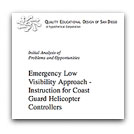
~ Lazarus Long

Prepared for EDTEC 544, Instructional Design, Fall 2006.  This artifact is an audience and needs analysis paper.
This artifact is an audience and needs analysis paper.
Understand that we live and work within systems of cause and effect in which actions may have multiple origins and consequences.
This project was part of the introductory instructional design course, EDTEC 544. The assignment involved identifying an instructional need, completing an audience, goal, task, and objective analysis, and designing a system specification that would fill the need. Shipboard air traffic controllers have faced many years where their skills have been maintained at a very basic level. New ships will have a much more complex air traffic picture, so any help our current controllers can get will help them in the near future.
How did the Coast Guard get to the point where their shipboard personnel are barely hanging on to vital air traffic control skills? Isn’t managing air traffic a vital mission requirement? Sadly, many small causes have combined to affect the state of readiness of our controllers. During the short time I spent conducting an initial analysis of the instructional problem, I came to see infinitely more than I had in over four years as a shipboard control trainer. The analysis process served to illuminate details that drove the erosion of skills. More importantly, the analysis also illuminated several systematic ways to reclaim a high proficiency with air traffic control.
Using a systematic interview process, it became clear that the problem with controller proficiency had multiple origins. Interviews with the right fleet experts yielded useful information. New people did not have the benefit of several years in which to view the tedious process of gaining and maintaining their qualifications. In addition to competing duties, a controller would often go several patrols without access to an aircraft. When an aircraft was available, other missions prevented any meaningful training. Most mission profiles must be completed in almost perfect conditions, so when there was bad weather (meaning perfect training weather), no missions were flown. Also, long periods at the pier with no access to appropriate simulators caused unused skills and knowledge to atrophy.
There is only so much review you can do by reading a book: air traffic control skills must be practiced. Finally, the main source for simulated air traffic control, the U.S. Navy, had stopped sending people to air traffic control school! Their controllers are trained at sea, on the job, and have sophisticated simulators. Unfortunately, the Coast Guard does not have the same depth of equipment. Our controllers were left without a way to get simulated time, and limited opportunities to get actual time.
Early on, I expected to develop an interactive multimedia simulation environment to teach and/or review terminology and practice air direction commands. My development environment of choice was flash, because the Coast Guard computing environment supported the SWF plug in at every computer terminal on every ship. As the assignment progressed, I realized the goal was not to actually develop the entire training system, but instead design the overall educational framework. This realization dampened my enthusiasm for the project a bit. I finally overcame my disappointment by developing what I could, in a framework that could be recycled by the Coast Guard instructional developers at a later date.
Another problem I faced was access to subject matter experts. The Ship-Helicopter standardization training team is located in Mobile, Alabama. Their instructors are rarely in the office. I was lucky that they had three trips to San Diego during the semester, and I was able to work with them during my initial analysis process. The local cutters were also underway more than they had been in the summer, and were reluctant to share their operational schedule with a non-crew member. However, I was able to meet with the air traffic controllers from CGC Chase on three occasions. Their input formed much of the audience and subject matter input for the initial analysis.
This project displays my ability to use analysis techniques as the basis for developing good, probing questions. I combined interviews, historical evaluative data, existing assessment cards, and personal knowledge to produce a detailed plan that presented novel information in a compellingly accessible report.
This work taught me the benefit of style sheets and ample white space. Using a standard template made it easy to track where certain information could be found. I have a long history of working (perhaps with too much zeal) to save paper. This effort broke me of my compulsion. I now allow myself plenty of white space to help frame the important information.
The last and most significant lesson I learned was the importance of triangulation. This concept was introduced as “the prism of perspectives”, which is an excellent starting point for audience and task analysis that takes into account internal and external individuals, direct and indirect recipients of a training or performance intervention, and includes both the existing literature and relevant theories of instruction. As a “lens” through which to direct your analytical gaze, the prism of perspectives is an extremely powerful tool.